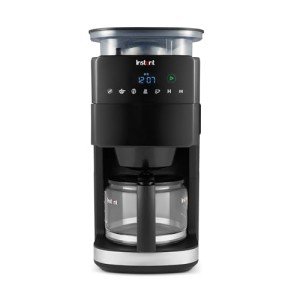9 Things Your Parents Teach You About Espresso Bean Grinder
페이지 정보
작성자 Zella Geach 작성일25-11-06 01:35 조회2회본문

The Ultimate Guide to Espresso Bean Grinders
Coffee enthusiasts know that the quest for the ideal espresso begins long before that abundant, dark liquid touches the cup. It starts with the beans and, more significantly, how they are ground. An Espresso Machine For Office bean grinder (Git.gkcorp.com.vn) plays a critical function in opening the tastes and fragrances hidden inside each coffee bean. In this thorough guide, we will explore the types of espresso mills, their functions, how to select the ideal one, and address common questions to guarantee you enjoy a perfect shot whenever.
The Importance of Grinding Espresso Beans
Espresso extraction is a delicate process that requires precision. The grind size directly affects the flavor and quality of the espresso shot. Fine ground beans increase area, allowing for faster extraction, while coarse grinds can cause under-extraction. This is why investing in a premium espresso bean grinder is crucial.
Table 1: Effects of Grind Size on Espresso
| Grind Size | Texture | Extraction Time | Flavor Profile |
|---|---|---|---|
| Coarse | Gritty | 25-30 seconds | Sour, under-extracted |
| Medium-Fine | Sand-like | 20-25 seconds | Balanced |
| Great | Powdery | 18-20 seconds | Rich, full-bodied |
| Extra Fine | Finer than powder | 15-18 seconds | Bitter, over-extracted |
Types of Espresso Grinders
When it pertains to espresso mills, 2 main types control the market: blade grinders and burr mills. Understanding the distinction in between these 2 types can assist customers make an informed decision.
1. Blade Grinders
Blade mills are usually the least pricey option and are much easier to utilize. They make use of a blade that spins quickly to chop the beans. However, they produce inconsistent grinds due to the irregular size of the resulting coffee particles. This inconsistency can significantly affect the quality of the Espresso Machine With Dual Shot.
Pros:
- Affordable and easy to discover
- Compact and portable
- Quick grinding process
Cons:
- Inconsistent grind size
- Can produce heat, impacting taste
- Less appropriate for espresso
2. Burr Grinders
Burr mills are often recommended by coffee connoisseurs. They are available in two varieties: flat burrs and cone-shaped burrs. Both types provide a consistent grind size, important for espresso.
Pros:
- Even grind size, improving flavor extraction
- Available in manual and electric variations
- Adjustable settings for various grind sizes
Cons:
- More costly than blade grinders
- Larger footprint in the kitchen
Table 2: Comparison of Blade vs. Burr Grinders
| Feature | Blade Grinder | Burr Grinder |
|---|---|---|
| Consistency | Irregular | Highly constant |
| Grind Size Adjustability | No | Yes |
| Heat Generation | Moderate to high | Very little |
| Price Range | Low | Moderate to high |
| Ideal for | Basic brewing | Espresso and advanced developing |
Features to Consider When Choosing an Espresso Grinder
When choosing an espresso bean grinder, it's important to consider numerous aspects that determine its efficiency, benefit, and longevity.
1. Grind Settings
A grinder with numerous grind settings allows for flexibility across different coffee designs. A perfect espresso grinder must have at least 15 different grind size options.
2. Construct Quality
Material quality influences the grinder's durability and performance. Stainless steel burrs are a good choice as they are robust and do not rust.
3. Grinding Speed
Higher RPM (transformations per minute) makes the grinding process quicker however can produce more heat. Go for grinders that balance speed and heat generation.
4. Hopper Capacity
Consider how much coffee you normally brew. A larger hopper can hold more beans, lowering the frequency of refills. Nevertheless, a smaller sized hopper is more compact and can suit tighter areas.
5. Cost
Quality espresso grinders can range from around ₤ 50 for entry-level blade choices to over ₤ 1,000 for high-end burr grinders. It's essential to ensure that the grinder matches your brewing requirements and budget.
Frequently Asked Questions (FAQ)
What grind size should I utilize for espresso?
For espresso, a fine grind is typically suggested. The normal range is around 20 microns, however adjustments can depend upon the coffee variety and your specific Espresso Pod Machine machine.
How often should I grind my espresso beans?
For the very best taste, it is a good idea to grind beans simply before developing. Freshly ground coffee offers superior aroma and taste compared to pre-ground choices.
Can I use a blade grinder for espresso?
While it is possible to use a blade grinder, it is not suggested for espresso due to the absence of constant grind size, which can cause unfavorable taste outcomes.
What is the difference in between conical and flat burr grinders?
Both types deliver a consistent grind size; nevertheless, cone-shaped burrs tend to produce less heat and keep less premises. Flat burrs can grind quicker but might create heat, impacting taste. Conical burrs are normally preferred for espresso.
Is it worth buying a high-end grinder?
Definitely. A premium grinder can considerably boost the espresso experience by providing consistency and much better extraction, resulting in a richer and more tasty shot.
An espresso bean grinder is more than just a kitchen area tool; it is a crucial component in the art of coffee preparation. Comprehending the types of grinders, their features, and importance can assist anyone from casual drinkers to baristas raise their espresso game. Whether investing in a manual burr grinder or a high-end electrical model, prioritizing grind quality will unquestionably offer a much better espresso experience. Delight in every sip-- after all, it all starts with the grind!























 Home
Home  고객센터
고객센터 




